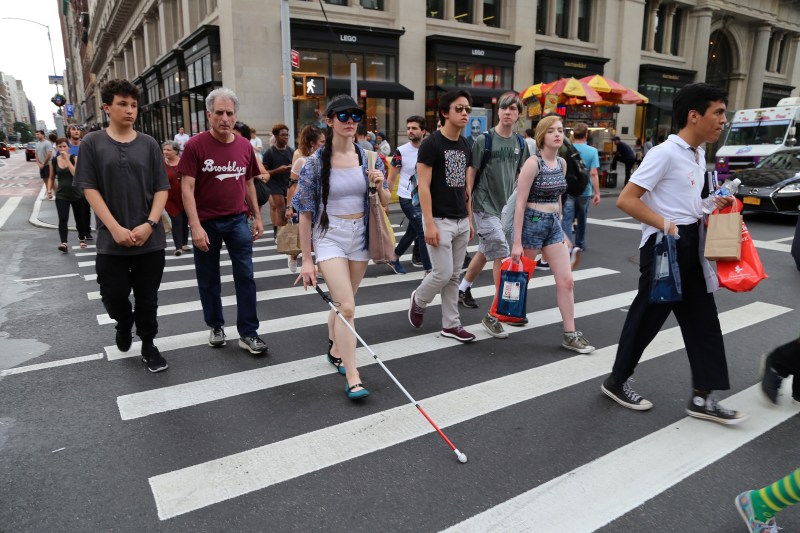Op-Ed: Bringing the Disability Community Into Vision Zero
DOT's chief accessibility specialist on the challenges and successes of inclusion.

In cities around the world, Vision Zero has furthered governments’ main priority: to protect the public. Its success lies in coalition-building among affected residents, advocacy organizations, and government agencies. For all these efforts, however, one piece often remains absent from the Vision Zero conversation: an explicit dialogue about how to engage the disability community and how to reflect its voices in our work.
A few months after the city’s Vision Zero agenda became public in 2014, I joined the Department of Transportation as the agency’s first policy analyst for accessibility. (I’m now the chief accessibility specialist.) I began working closely with senior managers and their staff to bring forward efforts for enhancing the accessibility of our streets, and to establish a bridge between the agency and the disability community.
Every Vision Zero project improves the streetscape, and therefore can enhance accessibility for all New Yorkers. For example, a protected bike lane adds medians to the roadway, which shortens the lengths of crosswalks and allows for refuge islands. These improvements are a huge win for pedestrians whose gait is not what it used to be, or for people who lack the stamina to cross a long avenue without pausing.
Raised crosswalks also benefit a wide range of people. Advocates for reducing speed limits in residential neighborhoods love raised crosswalks; parents concerned about the visibility of their children also are huge fans. Of course, the disability community sees a raised crosswalk as a tremendous win for safety, as does the ever-growing aging population, who may feel at risk when they can’t make eye contact with an SUV or truck driver. No matter the intervention, the Vision Zero toolbox is packed with solutions that affect walkability as much as livability.
Yet, often the public conversation about these interventions doesn’t include the persons with disabilities who can most benefit. As human beings, we tend to gravitate toward what we know best and makes us feel comfortable, which can stop us from seeing the world as it is. Thus blinded, we believe the world exists only in the way that we experience it. It can be difficult for a person without a disability to consider what it would be like to navigate a street for a person with one.

That’s not a luxury that extends to government. It is our duty, as the guardians of the public, to protect all pedestrians. Engineers, planners, and government officials must get comfortable speaking about accessibility, especially about connecting the dots between the shared interests of people with and without disabilities and the accessibility improvements benefit everyone. When city officials are not open about processes and public engagement, efforts to improve access for all stakeholders, especially vulnerable road users, can go unnoticed.
I see my role at the New York City Department of Transportation as helping to transform this culture of fear into one of comfort with the unknown. Tapping into my own disability has been my strongest asset. As an internal advocate and policy officer, I have been able to fold diverse voices and experiences that have not always been present into the work of the agency. I have accomplished this by hosting various disability advocates, representing a coalition of New Yorkers with disabilities, at the agency headquarters on a quarterly basis.
I also maintain an open dialogue with the Mayor’s Office for Persons with Disabilities, and constantly update and solicit input from the commissioner and his staff on new projects. Together, we ensure that the interests and experiences of the disability community are thoroughly represented. A productive harmony exists between the disability community and agency staff. End users are talking with our planners, policy officers, and engineers, and together, we all carry the weight of the success of Vision Zero.
We need to work out still more issues in order to institutionalize diverse voices and bring a sense of belonging into the process of transforming a street. But, over the last five years, that missing piece of the puzzle has become a lot smaller. It will continue to shrink as we bring more people of diverse backgrounds and experiences to the table. Internally, we study the diversity of our projects and the communities we serve throughout the agency in order to better understand our own comfort zones and oversights. Externally, we hear from New Yorkers on their own time, via a mobile-first feedback portal.
To tackle underrepresentation in the Vision Zero city, officials must undertake these all-important steps: Open the conversation, make all stakeholders visible, and look for your own oversights. Another way to close the void of underrepresentation is by hiring more persons with disabilities in all sectors of government. Americans with disabilities are one of the largest overeducated minorities with one of the highest rates of unemployment.
To my fellow individuals with disabilities, I say: It’s time we jump in and join the conversations. The microphone has never been louder, and our voices are needed today more than ever.
Quemuel Arroyo is the chief accessibility specialist at the New York City Department of Transportation. A version of this article first appeared in Transportation Alternatives’ Vision Zero Cities Journal.






